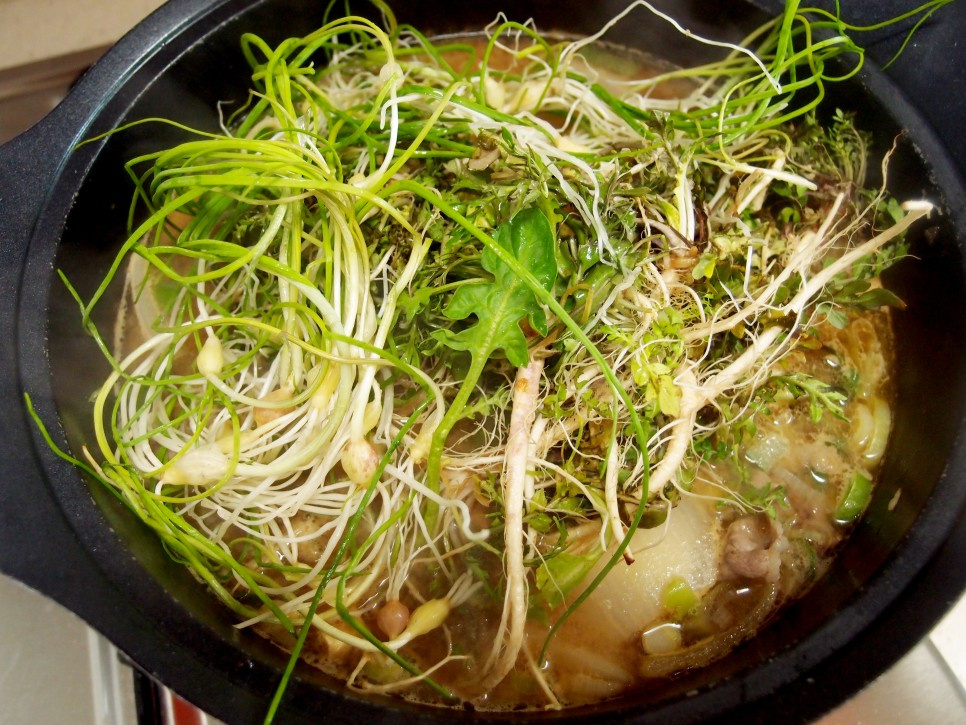Aromatic Spring Greens and Brisket Doenjang Hot Pot
#SpringVegetables #NasturtiumRecipe #WildChiveRecipe #DoenjangHotPotRecipe #SpringDish #HeartyMeal #HomemadeRecipe

This Doenjang (Korean fermented soybean paste) hot pot is brimming with the fragrant flavors of nasturtium and the pungent aroma of wild chives, which are in season during spring. The rich taste of beef brisket combined with the savory Doenjang creates an irresistible flavor that will have you finishing your rice in no time. This recipe is a recreation of a dish I fell in love with at a jokbal (pig’s trotters) restaurant years ago. The slightly bitter taste of the nasturtium, along with its excellent flavor, is perfectly complemented by the savory broth. I bought extra nasturtium and wild chives to recreate this delightful, freshly cooked hot pot. The brisket is just a delicious bonus! I used two types of Doenjang: a concentrated ‘Deot Doenjang’ and a seafood-based ‘Bajirak Kkotge Doenjang’ (clams and crab Doenjang). Mixing them helps balance the strong flavor of the Deot Doenjang. Using rice water not only mellows the fermented soybean paste’s robust taste but also helps eliminate any gamey odor from the beef, resulting in a cleaner, more refined broth. Enjoy a hearty and delicious meal infused with the vibrant spirit of spring with this Nasturtium and Wild Chive Brisket Doenjang Hot Pot, perfect for special occasions or any day you crave a comforting taste of the season.
Main Ingredients- Beef brisket 150g
- Nasturtium (Nangi) 100g
- Wild chives (Dallae) 30g
- Firm Tofu 1 block
- Kabocha squash (Danho-bak) 1/4
- Onion 1/2
- Rice water 1L
Cooking Instructions
Step 1
First, let’s prepare the fragrant spring vegetables. Thoroughly clean the roots of the nasturtium (nangi) to remove any dirt. Wash them under running water and then let them drain completely in a colander.

Step 2
Next, prepare the wild chives (dallae), a springtime delicacy. Since they can also have dirt attached, be sure to wash them gently in cold water. Once clean, squeeze out any excess water.

Step 3
Now, let’s start cooking the hot pot. Place the beef brisket in a pot without adding any oil. Cook over medium heat. This process will naturally render the rich juices and fat from the brisket.

Step 4
As the brisket sizzles and cooks, its delicious fat will naturally render out. This fat will add depth and flavor to the hot pot.

Step 5
Here comes the secret to the flavor: the Doenjang. For this recipe, I’m mixing two types: Deot Doenjang, which is a concentrated paste, and a store-bought Bajirak Kkotge Doenjang (clam and crab Doenjang). While Deot Doenjang offers a deep, robust flavor, combining it with the Bajirak Kkotge Doenjang creates a smoother and more complex taste. Feel free to use regular Doenjang if that’s what you have; it will still be delicious! Add 1 tablespoon of minced garlic to enhance the aroma.

Step 6
Pour 1 liter of rice water into the pot with the mixed Doenjang and garlic. Bring it to a rolling boil over high heat. Skim off any foam and excess fat that rises to the surface with a spoon; this will make the broth cleaner and more refreshing. Rice water helps to mellow the strong fermented flavor of the Doenjang and also removes any gamey smell from the brisket.

Step 7
Once the broth is boiling vigorously, add the prepared kabocha squash (danho-bak) and onion. I’ve omitted carrots as they might not harmonize as well with Doenjang hot pot. Using kabocha squash instead of zucchini adds a subtle sweetness that helps balance the richness of the brisket and its fat, enhancing the overall broth flavor.

Step 8
When the vegetables are slightly tender, add the firm tofu and chopped green onions. Initially, let it boil vigorously on high heat. Once it comes back to a boil after adding the tofu and green onions, skim off any foam again, then reduce the heat to medium-low and let it simmer gently. This slow simmering allows the ingredients to meld their flavors beautifully.

Step 9
This is the final step! Arrange the prepared nasturtium and wild chives over the hot pot and immediately turn off the heat. The residual heat from the gently simmering broth will be sufficient to cook the greens, preserving their fresh aroma and delicate texture. Be careful not to overcook them, as they can become too soft.

Step 10
Your Nasturtium and Wild Chive Brisket Doenjang Hot Pot, fragrant with the essence of spring, is now ready! The brisket lends a deep and rich flavor to the broth, while the fresh aromas of nasturtium and wild chives awaken your palate. Taste the broth and, if needed, adjust the seasoning by adding a little more Doenjang. Enjoy this hearty and delicious meal with a bowl of warm rice!




